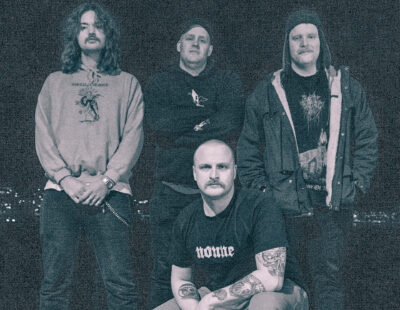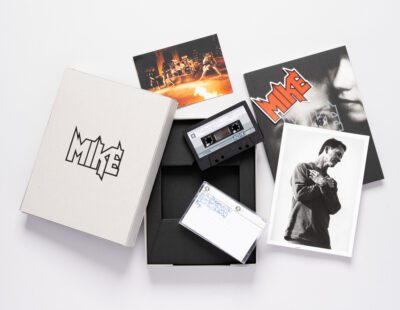It’s been a good month for celebrating the noisier side of the extremely extreme. All good things must end… though it’s hard to believe that we won’t be revisiting gritty, shadowy, unfettered sound in the future, if only here on the Deciblog.
To round out the month of noise, we spoke to Virginia-based Christopher S. Feltner about his own journey through recordings and performance. While he is most certainly an engaged musician, we have mostly encountered his live physical performance work, which uses ugly sound as merely a bed for off-putting stage action while wearing an uncomfortable (for the audience) clash of garments. We have witnessed Feltner, head and face gauzily covered, stalk a room with a knife whose sharpness is demonstrated by shoving it into a wooden table; the knife is then used to slash a mouth-sized wound into the facial shroud, then forced between Feltner’s lips. The audience sat utterly transfixed, stunned as red liquid streamed from Feltner’s face, wondering whether it was all part of the act or if he was shedding real blood in front of them.
While the anguish Feltner channels is real, he also makes easy conversation and is straightforward about his artistic interests. Below is a sample of his recorded output, as well as a brief interview and a video sample of a Philadelphia performance.
It’s almost August, but that’s okay – keep it noisy if you want to!
Can you describe how your musical interests (d)evolved toward working with noise?
Aggressive music has always been appealing to me. From age 14, I have played in punk, metal, and hardcore bands. I saw a music review for Wolf Eyes’ Burned Mind in a magazine. The review didn’t really interest me as much as the photos that were included: members head banging and going nuts with instrumentation that I couldn’t imagine being heavy. I picked up the album, and fell down the rabbit hole.
Did your interest in music/noise lead you to performance art, or did that develop separately?
My interest in performance art started about two years ago. I saw Gerritt Wittmer and Paul Knowles perform in Baltimore, and it opened another door that I didn’t know was there. Their performance mixed a subtle, but strong, physical presence with a noise composition. Before that, I had always thought of noise and performance art as separate entities. Since then, I have come across other artists that mix noise/sound and performance art, masterfully, like Olivier de Sagazan, and Yann Marrusich.
What do you see as the connection between the sound involved in your performances and the physical aspects? Does either one feel more important or require more of your attention than the other?
The connection between the sound, and the physicality, is 100% intentional. Sometimes I want the sound to be the dominant presence; sometimes, the opposite. It all depends on the concept of what I’m performing, the performance space, and how much control I have over the lighting in the room.
I don’t consider one to be more important from a creative aspect. But, in my opinion, if you’re going to be performing live, then there should be a solid physical presence. Nothing turns me off more than people staring at a laptop, or standing still, turning knobs the whole time.
What is your performance experience like? How widely have you performed (geographically) and at what kinds of shows?
This is my sixth year performing solo work. I have performed in 18 or 19 states, at this point, and multiple times. I have performed in a lot of different types of spaces: bars, clubs, houses, galleries, DIY performance spaces, schools, residential treatment center, museum… I have opened for Melt-Banana in a popular DC club, and I have played for 10 people in a kitchen in North Carolina.
What are your current sources of inspiration for your noise/performance work?
Films are a constant source of inspiration for me. David Lynch’s films, in particular. Unusual paintings and photography also charge me. My faith in Christ. The human condition. It all plays a part. I have noticed that the longer I do this, the less inspired I am by specific artists.
Can you talk about the first noise or performance piece you completed that you felt really proud of?
The first noise piece I had completed that I felt really proud of was the first Kingdom of Sharks album, “ALPHA/OMEGA.” The release was my audible interpretation of what creation would sound like in the book of Genesis, and then of Revelation. It was my first attempt at a full release, and, even now, it still holds up.
The first performance piece that I was proud of was one I made based on my dog. He started having severe seizures, and it was really sad to see how helpless and confused the episodes made him, and how much of a toll they took on his health. The performance is on YouTube. I did the performance in Philadelphia at Common Circuit Fest.
You’ve said that people tend not to talk to you after performances. Can you talk about some counterexamples – people who have been really enthusiastic with you after experiencing your work?
If people are used to unusual performances, they tend to be the ones who will talk more. The problem is, they want to talk immediately following the performance which is the worst time for me. It takes some time to get back to normal after. I try to be friendly, and answer questions, but I’m not quite there yet. The more intense the performance is, the more time I need after to myself.
I had a guy who was working on a documentary of performances at this space outside of DC wanting to ask me all of these questions right after a rough performance. Then, he wanted me to fill out and sign this permission form. It was really bad timing.
In Hildebran, NC, as soon as I stopped the performance, two people immediately wanted to know what my influences were. That was very strange, and unexpected to me.
Have you worked with more or less the same set of props/clothing in your various performances, or have you accumulated/changed these over time?
Before mixing more performance-based elements into what I do, I dressed as I normally would. Once I started performing under my own name vs. the Kingdom of Sharks moniker, I began dressing in white button-up shirt, black tie, pants, socks, and dress shoes. Then, for some performances, I began using the white head covering in addition to the outfit. Now, at times, I’ll alternate a black head covering, and dark green button-up shirt.
The clothing, and the variance in the use of the head covering, is all intentional, and depends on what I’m performing.
Do you have any go-to instruments or materials you like to use when recording, or is it different all the time?
Honestly, it all depends on the concept, or approach, for the album. I use my voice in most of my recordings. Sometimes it sounds like I’m using other things when it’s just vocal-based. Didgerdoo is something I have used multiple times. Those are really the only two things I have used the most. I was just talking to my brother-in-sound, Guillermo Pizarro, about new recording ideas. I have 10 different concepts/approaches ready to go when I’m ready.
How and why did SEVEN1878 get started? What goals do you have for the imprint?
SEVEN1878 was just a name I put on a former project of mine, Spoken War. I wanted to do a small label of some sort but I didn’t have the time, or much focus at the time. Then, it became a blog promoting interesting art. Fast forward seven years later, it is a modest label imprint that has put out releases by myself, and several others; it a music blog with reviews and interviews with experimental-based artists; and, it is a show organizing entity.
My goals as an imprint is to present experimental expression to as many people as are willing to give it a chance. Much like I fell into the rabbit hole of this world of sound, I’m hoping to do the same for others.
Check out more noise insanity by Feltner and his conspirators at the SEVEN1878 webpage, Feltner’s direct page, and at his music blog.
Also, don’t miss a similarly riveting interview conducted by TMaFLH alumnus Guillermo Pizarro.






